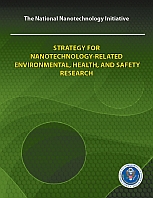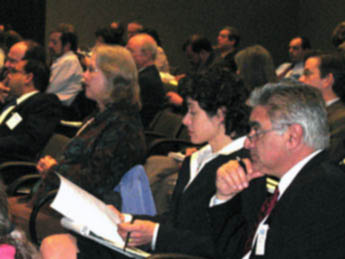NNI Environmental, Health, and Safety Issues
Nanotechnology encompasses an increasing number of activities based on the ability to measure, see, and control matter at the scale of nanometers. Nanoscale circuitry is already in cell phones and other electronic products on the market today. Many applications that are envisioned will take advantage of the fact that, at the nanoscale materials have different chemical and physical properties than materials at larger scales. Also, there is potential for nanosized particles to be transported through cell walls and other biological barriers in ways that are different from their macroscale counterparts. These properties can be used to make better batteries, to deliver drugs where they are needed, and to clean contaminated soil and groundwater. The ability to control matter at the nanometer scale is leading to technological advances in many areas, including energy, medicine, and the environment.
NNI Strategy for Nanotechnology-Related Environmental, Health, and Safety Research
 The Nanoscale Science, Engineering, and Technology (NSET) Subcommittee of the Committee on
Technology, National Science and Technology Council (NSTC) released the document
Strategy for Nanotechnology-Related Environmental, Health, and Safety Research (PDF), describing the NNI's strategy for addressing priority research on environmental, health, and safety (EHS) aspects of nanomaterials.
The Nanoscale Science, Engineering, and Technology (NSET) Subcommittee of the Committee on
Technology, National Science and Technology Council (NSTC) released the document
Strategy for Nanotechnology-Related Environmental, Health, and Safety Research (PDF), describing the NNI's strategy for addressing priority research on environmental, health, and safety (EHS) aspects of nanomaterials.
NNI Environmental, Health, and Safety Research Prioritization Report
The National Nanotechnology Coordination Office (NNCO), on behalf of the Nanoscale Science, Engineering, and Technology (NSET) Subcommittee of the Committee on Technology, National Science and Technology Council (NSTC) released the document Prioritization of Environmental, Health, and Safety Research Needs for Engineered Nanoscale Materials (PDF).
FDA Nanotechnology Report Outlines Scientific, Regulatory Challenges
The U.S. Food and Drug Administration (FDA)'s Nanotechnology Task Force's report recommends that the agency consider developing guidance for manufacturers and researchers and taking other steps to address the benefits and risks of drugs and medical devices using nanotechnology.
ICON Online Journal for Risk Research
 A new monthly online journal with citations and links to articles on the environment and health impacts of nanotechnology is now available online. The Virtual Journal of Nanotechnology Environment, Health & Safety (VJ-Nano EHS), was developed to improve access to information in peer-reviewed scientific articles.
A new monthly online journal with citations and links to articles on the environment and health impacts of nanotechnology is now available online. The Virtual Journal of Nanotechnology Environment, Health & Safety (VJ-Nano EHS), was developed to improve access to information in peer-reviewed scientific articles.
VJ-Nano EHS organizes the information contained in the EHS database into a reader-friendly monthly journal format, primarily listing articles published during the current month. The journal is a joint project between the International Council on Nanotechnology (ICON) and Rice University's Center for Biological and Environmental Nanotechnology (CBEN), which also established its EHS database in August 2005
Understanding Risk Assessment of Engineered Nanomaterials
How can we know what is a risk and what is not?
Risk assessment of engineered nanomaterials is the work of many scientists today. And, as they will attest, evaluating risk is a complex process.
In order to help with assessing risk-related research, the National Nanotechnology Coordination Office commissioned an article called Understanding Risk Assessment, written by a science journalist, Trudy Bell.
EPA White Paper on Nanotechnology
 The Environmental Protection Agency (EPA)’s Science Policy Council issued a Nanotechnology White Paper (EPA/100/B-07/001, February 2007) on science issues and needs associated with nanotechnology. This paper is a revision of the peer-reviewed draft released and put out for public comment in December 2005. For more information on the White Paper or to download a copy, please visit the EPA website.
The Environmental Protection Agency (EPA)’s Science Policy Council issued a Nanotechnology White Paper (EPA/100/B-07/001, February 2007) on science issues and needs associated with nanotechnology. This paper is a revision of the peer-reviewed draft released and put out for public comment in December 2005. For more information on the White Paper or to download a copy, please visit the EPA website.
EPA also has posted A Fact Sheet on Nanotechnology under the Toxic Substances Control Act.
Public Views on EHS Research Needs for Engineered Nanoscale Materials
 Participants at the public meeting on
Participants at the public meeting on
- The complete news release
- Transcript from the meeting
- Presentations from the meeting
- Public comments
The agencies of the NNI had requested input on the research needs, identified in a document published in September 2006, and on the prioritization criteria for such research needs. (See NNI's EHS Research Needs). The public input will be used to formulate the government's recommended priorities for safety-related research on nanomaterials, which, in turn, will guide agencies and program managers who fund research in the field.
NSET Document: Environmental, Health, and Safety Research Needs for Engineered Nanoscale Materials
 The Nanoscale Science, Engineering, and Technology (NSET) Subcommittee of the National Science and Technology Council's
Committee on Technology has released a document identifying environmental,
health, and safety (EHS)
research and information needs related to understanding and management of potential risks of engineered nanoscale materials.
(PDF)
The Nanoscale Science, Engineering, and Technology (NSET) Subcommittee of the National Science and Technology Council's
Committee on Technology has released a document identifying environmental,
health, and safety (EHS)
research and information needs related to understanding and management of potential risks of engineered nanoscale materials.
(PDF)
The document will be used by Federal agencies participating in the National Nanotechnology Initiative (NNI) to inform and guide research programs. It also communicates to industry, universities, and other nongovernment research entities approaches for obtaining the knowledge and understanding necessary to enable risk assessment and management of nanomaterials. Read more.
Download Report (841 KB)
Responsible development of nanotechnology includes supporting fundamental discovery-based research as well as targeted research and other activities to understand potential risks associated with the manufacture and use of engineered nanoscale materials. Since the inception of the National Nanotechnology Initiative, the participating agencies have supported research to safely develop and apply nanotechnology for societal benefit and economic growth as well as research to better protect public health and the environment. By integrating the results of such research, the NNI aims to ensure the benefits of this new technology are maximized within a coordinated research framework that emphasizes understanding and prioritizing potential risks as well as the means to manage such risks.
Nanotechnology-related environmental, health, and safety (EHS) research is an essential component of the NNI's coordinated research framework. EHS research is focused in particular on understanding general mechanisms of biological interaction with nanomaterials and on developing broadly useful tools and tests for characterizing and measuring nanomaterials in various environments, including in the body. This research is to understand the effects of address the potential implications of engineered, incidental, and natural nanomaterials; remove contaminants from soil and water; and prepare for a new generation of nanoproducts. Nanotechnology-related EHS research is also informed and influenced by all other components of the broader NNI research portfolio, including research on fundamental nanoscale phenomena and processes; nanomaterials; nanoscale devices and systems; instrumentation, metrology, and standards; nanomanufacturing; and societal dimensions (ethical, legal, and other societal issues).
Funding
NNI research on environmental, health and safety (EHS) aspects of nanomaterials has increased steadily. Between fiscal year (FY) 2005, the first year for which estimates are available, and the President's request for 2009, the NNI will invest an estimated $256 million in research that is primarily aimed at understanding the risks posed by nanomaterials. This funding and corresponding effort to advance understanding of nanotechnology-related environmental, health, and safety issues is leveraged by a significant amount of additional investment in instrumentation, metrology, facilities, and fundamental materials research. This research and other NNI activities are coordinated by the Nanotechnology Environmental and Health Implications (NEHI) Working Group under the Nanoscale Science, Engineering, and Technology (NSET) Subcommittee of the National Science and Technology Council.
In FY 2009 EHS R&D funding ($76 million) is over double the level of actual funding in 2005 ($35 million), the first year this data was collected. The steady growth in EHS R&D spending follows the NNI strategy of expanding the capacity to do high-quality research in this field. The proposed $76 million for 2009 does not include substantial research in instrumentation and metrology and on fundamental interactions between biosystems and engineered nanoscale materials, both of which are important in the performance and interpretation of toxicological research. An indication of the level of funding for these broader categories of nanotechnology-related EHS research may be deduced from the detailed 2006 data collected and analyzed specifically for this purpose. This data showed that the total funding for nanotechnology-related EHS research in 2006 was about $68 million, 80% higher than that reported for "primary purpose research."